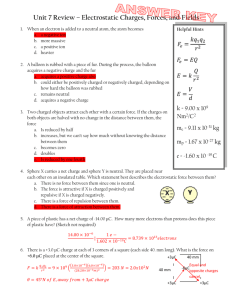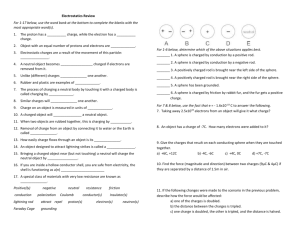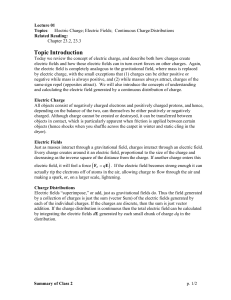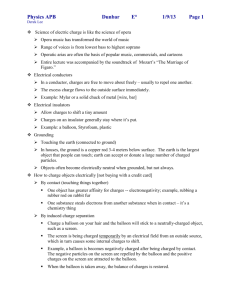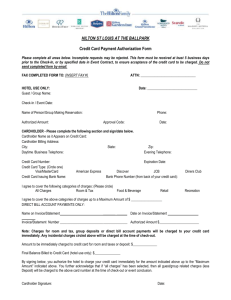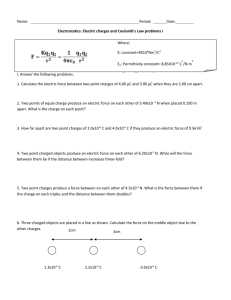Electrostatics
advertisement
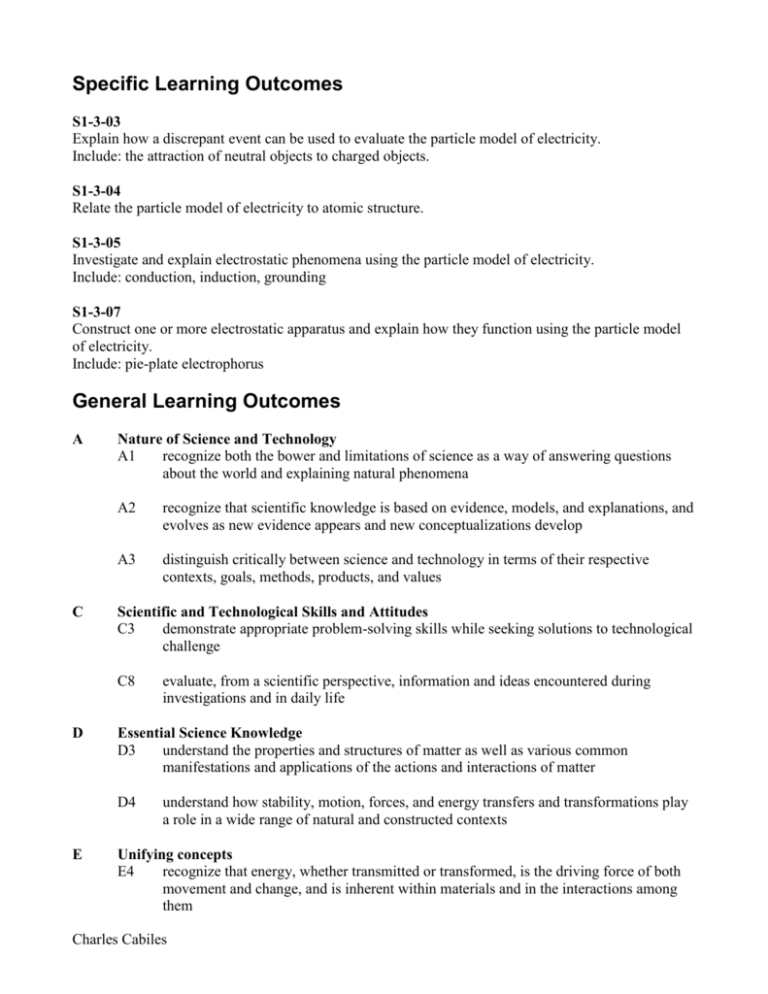
Specific Learning Outcomes S1-3-03 Explain how a discrepant event can be used to evaluate the particle model of electricity. Include: the attraction of neutral objects to charged objects. S1-3-04 Relate the particle model of electricity to atomic structure. S1-3-05 Investigate and explain electrostatic phenomena using the particle model of electricity. Include: conduction, induction, grounding S1-3-07 Construct one or more electrostatic apparatus and explain how they function using the particle model of electricity. Include: pie-plate electrophorus General Learning Outcomes A C Nature of Science and Technology A1 recognize both the bower and limitations of science as a way of answering questions about the world and explaining natural phenomena A2 recognize that scientific knowledge is based on evidence, models, and explanations, and evolves as new evidence appears and new conceptualizations develop A3 distinguish critically between science and technology in terms of their respective contexts, goals, methods, products, and values Scientific and Technological Skills and Attitudes C3 demonstrate appropriate problem-solving skills while seeking solutions to technological challenge C8 D Essential Science Knowledge D3 understand the properties and structures of matter as well as various common manifestations and applications of the actions and interactions of matter D4 E evaluate, from a scientific perspective, information and ideas encountered during investigations and in daily life understand how stability, motion, forces, and energy transfers and transformations play a role in a wide range of natural and constructed contexts Unifying concepts E4 recognize that energy, whether transmitted or transformed, is the driving force of both movement and change, and is inherent within materials and in the interactions among them Charles Cabiles Cluster 0: Overall Skills and Attitudes S1-0-2b S1-0-3e S1-0-5d S1-0-6d S1-0-7a S1-0-7c S1-0-7e S1-0-8a S1-0-8b S1-0-8c S1-0-9d evaluate the reliability, bias, and usefulness of information determine criteria for the evaluation of an STSE decision evaluate, using pre-determined criteria, different STSE options leading to a possible decision adjust STSE options as required once their potential effects become evident draw a conclusion that explains the results of an investigation implement an STSE decision and evaluate its effects reflect on prior knowledge and experiences to develop new understanding distinguish between science and technology explain the importance of using precise language in science and technology describe examples of how scientific knowledge has evolved in light of new evidence, and the role of technology in this evolution value skepticism, honesty, accuracy, precision, perseverance, and open-mindedness as scientific and technological habits of mind Charles Cabiles Lesson 1: Charged Objects Cluster: Nature of Electricity Grade: Senior 1 Period: 70 minutes Learning Outcomes/Goal Focus A. Scientific Inquiry Initiating, Researching, Planning The students’ prior knowledge regarding the concepts of negatively, positively, and neutrally charged objects; as well as the laws of attraction and repulsion will be assessed through their manipulation of models that they will be creating. Implementing: Observing, Measuring, Recording Students will create a visual/conceptual model of charged objects and how they are affected by other charged objects. Analyzing and Interpreting Analyzing and interpreting the concepts of charged objects and the laws of attraction & repulsion using manipulatives. Concluding and Applying Developing operational definitions of: negatively charged objects, positively charged objects, neutrally charged objects, the laws of attraction and repulsion will be based on prior knowledge and the observations made during the lesson activity. B. STSE Issues/Design Process/Decision-making N/A C. Essential Science Knowledge The relationship between positive and negative charges within an atom is connected to an object’s overall charge. Like charges repel each other. Opposite charges attract each other. What will you assess? Preconceptions regarding charged objects. The students’ ability to predict using the conceptual knowledge that they gain during the lesson. Developing operational definitions of: negatively charged objects, positively charged objects, neutrally charged objects, the laws of attraction and repulsion will be based on prior knowledge and the observations made during the lesson activity. How will you assess it? manipulative models journal entries Charles Cabiles Materials Required: large paper shapes (circles, squares, triangles) representing objects red bingo chips representing negative charges blue markers representing positive charges image of an atom (showing negative electron & positive core proton) sticky notes average book Procedure: Step 1 (5 minutes): Display the image of an atom on the overhead and briefly review: o Central nucleus of the atom is stationary and has a positive charge o Electron traveling around the nucleus has a negative charge o The atom is considered to have a neutral charge if there are the same amount of positive charges as there are to negative charges. 1 Negatively charged electron 1 Positively charged central nucleus Neutrally Charged Atom Step 2 (5 minutes): Question: “Since we know that neutrally charged atoms have the same amount of positive charges and negative charges, let’s now take a look at this average book. Is this book matter? What is the book’s matter made of? If we assume that this book contains the same amount of positive charges and negative charges, what charge would you think this book has?” o Answer: The book is matter and is made up of many atoms. It would have a neutral charge if the positive and negative charges were equal. Charles Cabiles Step 3 (10 minutes): Have each student construct a neutral object using the manipulatives given to them: o 1 paper shape = 1 object o red bingo chips = negative charges (to be placed on shape) o blue marker to draw positive charges on paper shape Have students check their partner’s model to see ensure they have created a neutral object (negative charges = positive charges) Question: “Why did I give you a blue marker to draw positive charges, instead of giving you blue bingo chips? o Answer: Drawing the positive charges reinforces the concept that positive charges are stationary and do not move. Step 4 (10 minutes): Tell students to remove 1 electron from their neutral object model. Question: “What is the difference between positive charges and negative charges in the object? Which type of charge is more abundant? What would the overall charge of the object be now?” o Answer: There is one less negative charge in the object. There are more positive charges than negative charges, so the overall charge of the object would now be positive. Question: “How would you make your object more positively charged than it already is now?” o Let students manipulate the models to come up with an answer. o Answer: By removing more and more negative charges, the object becomes increasingly positively charged. Step 5 (10 minutes): Let students arrange their models so that they have neutral objects again. Tell students to add 1 electron to the neutral object model. Question: “What is the difference between positive charges and negative charges in the object? Which type of charge is more abundant? What would the overall charge of the object be now?” o Answer: There is one additional negative charge in the object. There are more negative charges than positive charges, so the overall charge of the object would now be negative. Question: “How would you make your object more negatively charged than it already is now?” o Let students manipulate the models to come up with an answer. o Answer: By adding more and more negative charges, the object becomes increasingly negatively charged. Step 6 (10 minutes): Give a brief description on the Laws of Attraction and Repulsion: o Opposite charges attract o Like charges repel Roleplay (Opposite Charges) o Choose 2 students o Place a sticky note denoting a positive charge (+) on the first student. o Place a sticky note denoting a negative charge (-) on the second student. o Question: “According to the laws, what will happen to these 2 objects?” Students should roleplay by physically getting closer to each other. Charles Cabiles o Question: “Would it make a difference if the charges were rearranged?” Switch the charges on the two students. Answer: There would be no difference since both charges are still opposites and would attract. Roleplay (Like Charges) o Place sticky notes denoting positive charges (+) on both students. o Question: “According to the laws, what will happen to these 2 objects?” Students should roleplay by physically moving farther away from each other. o Question: “Would would happen if we had two negative charges?” o Place sticky notes denoting negative charges (-) on both students. Students should roleplay by physically moving farther away from each other. Step 7 (5 minutes): Tell students to pair up with someone at their group table. Pairs are to manipulate their two models so that they are representing: o Positive – positive relationships o Negative – negative relationships o Positive – negative relationships Teacher will be going around the room to formatively assess students’ understanding Step 8 (10 minutes): Students are to write in their journals. They are to write definitions in their own words for the following terms: o Negative charge o Positive charge o Neutrally charged object o Negatively charged object o Positively charged object o Law of attraction o Law of repulsion Step 9 (5 minutes): As an exit slip, each student is asked individually to represent one of the aforementioned terms by using their models as well as their own brief oral explanation of it. Charles Cabiles Lesson 2: Charged objects attract neutral objects Cluster: Nature of Electricity Grade: Senior 1 Period: 70 minutes Learning Outcomes/Goal Focus A. Scientific Inquiry Initiating, Researching, Planning “Balloon on wall” demonstration will initiate students’ prior knowledge and curiosity regarding static electricity. This demonstration will be explained so that the students will psychologically acquire the knowledge from this experience. Implementing: Observing, Measuring, Recording “Bending water” and “comb vacuum” are lab activities will provide students with evidential experiences. Analyzing and Interpreting Students will create manipulative models that will interpret what they have seen in the two aforementioned lab activities they have performed. Concluding and Applying Developing operational definitions of: insulators, conductors, Triboelectrical Series, “charged objects attracting neutral objects”. B. STSE Issues/Design Process/Decision-making Different perspectives can be used to scientifically explain the same phenomena. C. Essential Science Knowledge Insulators are made of materials that do not allow negative charges to pass through them easily. Conductors are made of materials that allow negative charges to pass through them easily. The Triboelectrical Series shows a relationship between different materials with respect to which materials readily give up negative charges and which materials readily accept negative charges. Charged objects attract neutral objects. What will you assess? Lab working skills. The students’ ability to interpret static electricity phenomena they witness while performing the lab activities with manipulative models Developing operational definitions of: insulators, conductors, the Triboelectrical Series, charged objects attracting neutral objects How will you assess it? manipulative models group work journal entries Charles Cabiles Materials Required: white paper scissors red bingo chips representing negative charges blue markers representing positive charges sticky notes rubber balloon metallic balloon combs fur plastic rod sink The Triboelectrical Series (handout) Procedure: Step 1 (5 minutes): Balloon demonstration o Rub the rubber balloon on your hair and place side that is rubbed on the wall o Rubber balloon should be stuck to the wall o Question: “How can you explain what has happened?” o Give some time for some class discussion. Step 2 (5 minutes): Handout the Triboelectrical Series to the students and explain how it works. o This series basically shows the relationship between different materials with respect to the materials’ ability to give up or accept negative charge (electrons). o Materials on the upper end of the series have the ability to give up their electrons easily, while the materials on the lower end have the ability to accept electrons easily. o When two materials are picked from the series, the material that is higher up on the chart has the ability to give up its electrons, which in turn are accepted and retained by the material that is lower on the chart. Question: “In the balloon demonstration, I rubbed a rubber balloon with the hair on my head. Using the Triboelectric Series, what can you tell me about the materials with respect to electrons?” o Answer: Since hair is higher up on the chart than rubber, electrons were given up by the hair and were transferred to the rubber balloon. Question: “What is the overall charge of the balloon?” o Answer: The balloon is negatively charged since it now has an abundance of negative charge (electrons). Step 3 (15 minutes): Let students create manipulative models in order to explain how the balloon stuck to the wall. o White paper and scissors are provided to cut out balloon and wall shapes. o Red bingo chips are used to represent negative charges o Blue markers are used to draw positive charges Charles Cabiles Students are most likely to come up with this representation: Figure 1 Negatively charged rubber balloon Wall o Students reasoning: Negatively charged balloon repels the neutral wall’s negative charge. The wall’s negative charge moves away from the balloon. The positive charge that is left after the charge separation is attracted to the negatively charged balloon, which keeps the rubber balloon “stuck” to the wall. ** This reasoning is correct except for one factor, which will be discussed in Step 4. Step 4 (10 minutes): Question: “If the balloon has an overall negative charge, then should the side of the balloon that is placed on the wall matter? o Rub rubber balloon on head again, but this time placing the side of the balloon that was not rubbed onto the wall. The balloon will not stick to the wall with this procedure. Give a brief explanation about insulators: o Insulators, such as rubber, are made of material that DO NOT readily allow electrons to pass through them. o Since the balloon is made of rubber, the negative charge that was placed on the balloon stays in the spot where it was rubbed Charles Cabiles Figure 2 Negatively charged rubber balloon Wall o This accurate representation shows that only one side of the balloon is negatively charged, while the other side remains neutral. The neutral side explains why that side of the rubber balloon did not stick to the wall. The balloon still has an overall negative charge, however the distribution of the charge is not homogenous. Step 5 (5 minutes): Give a brief explanation about conductors: o Conductors, such as metal, are made of material that DO readily allow electrons to pass through them. Allow students to predict what would happen if a metallic balloon was used by using their models. Demonstrate rubbing a metallic balloon with your hair and place on the wall. The representation that the students come up with should resemble what they had originally thought of in Figure 1. Since the metallic balloon is a conductor, the negative charge transferred to the balloon is evenly dispersed throughout the balloon’s surface. The metallic balloon would have an overall negative charge. **Note: The balloon may not stick to the wall due to the fact that not enough negative charge was transferred over. A weak negative charge on the balloon may not be strong enough to allow it to stick to the wall. Charles Cabiles Step 6 (25 minutes): Students are to get into groups of 4 and are to perform 2 activities: o “bending water” a low flowing stream of water is to be let out of the sink tap an ebonite rod is to be rubbed with fur the rod is to be placed near the stream of water **Students should be able to see the stream of water bending towards the rod. o “comb vacuum” tiny pieces of paper are ripped up and placed on the table a comb is combed through a students hair several times the comb is brought near the pieces of paper **Students should be able to see the pieces of paper being attracted to the comb. Students are to create a model of each experiment using the provided materials (paper, red bingo chips, blue markers) Students are to interpret what they experienced in the lab activities with their models o Students should be aware that they can use the Triboelectrical Series handout if needed. Teachers will be formatively assessing student/group work and their understanding of the concepts o Explanations of these 2 activities should resemble Figure 2. The charged object (rod, comb) receives a negative charge. The negative charges in the neutral stream of water and neutral pieces of paper are repelled away from the charged object, which leaves a positively charged side. This positively charged side is attracted to the charged object, which explain why the stream of water bends towards the rod, and why the pieces of paper are attracted to the comb. Step 7 (5 minutes): Students are to write in their journals. They are to write definitions in their own words for the following terms: o insulators o conductors o the Triboelectric Series o “charged objects attracting neutral objects” Charles Cabiles Triboelectrical Series Materials that are able to give up their electrons easily and cannot retain them very well. o o o o o o o o o o o o o o o o o o o o o o o o o o o o human hands rabbit fur glass human hair nylon wool fur lead silk aluminum paper cotton steel wood amber hard rubber nickel, copper brass, silver gold, platinum polyester Styrofoam saran wrap polyurethane polyethylene polypropylene vinyl silicon teflon Materials that are unable to give up their electrons easily, but are able to retain them very well. Charles Cabiles Lesson 3: Induction and Conduction Cluster: Nature of Electricity Grade: Senior 1 Period: 70 minutes Learning Outcomes/Goal Focus A. Scientific Inquiry Initiating, Researching, Planning Review of “charged objects attracting neutral objects” from previous lesson will become the leadin to induction. Previous conceptual knowledge and experience in using manipulative models will benefit students in understanding the concepts of induction and conduction. Implementing: Observing, Measuring, Recording An electroscope will be part of a demo that will allow students to observe electrostatic phenomena. Analyzing and Interpreting Students will perform roleplays which will represent the processes of induction and conduction. Concluding and Applying Developing operational definitions of: induction, conduction, and grounding. B. STSE Issues/Design Process/Decision-making Different perspectives can be used to scientifically explain the same phenomena. C. Essential Science Knowledge Induction is the process by which a charged object produces the opposite charge on a neighbouring object without direct contact. Conduction is the process by which a charged object produces the same charge on a neighbouring object by making direct contact. Grounding is the process in which a conductor is connected to the ground (earth) via a conducting material. What will you assess? group working skills. The students’ ability to interpret static electricity phenomena they witness with the use of roleplays. Developing operational definitions of: induction, conduction, and grounding How will you assess it? roleplays group work journal entries Materials Required: sticky notes (to represent charges) & markers paper model of the electroscope apparatus, bingo chips (negative charges), blue marker (positive charges) electroscope, fur, ebonite rod Charles Cabiles Procedure: Step 1 (10 minutes): Question: “Last class, we looked at how charged objects attract neutral objects. How does this happen?” o Answer: Charged objects (negative) repel the negative charges in neutral objects, which causes a charge separation. A positive side is produced, which in turn is attracted to the negatively charged object. o A quick drawing on the chalkboard can be used to aid this explanation. Give brief explanation of induction and connect the concept to previous class, specifically the aforementioned concept of “charged objects attracting neutral objects”. o Charged objects create a charge separation in neighbouring neutral objects. o The charged objects do not directly make contact with the neutral object. Step 2 (15 minutes): Allow students to predict what they would see before demonstrating induction with the electroscope apparatus. Demonstrate induction by using the electroscope: o Rub ebonite rod with fur o Question: “What charge will this ebonite rod have?” Answer: Using the Triboelectric Series, the rod would acquire a negative charge. o Bring rod close to (but not touching) the metallic disk on top of the electroscope. o **Students should see the two metal leaves separate on the inside of the electroscope. Explain this evidential experience using a paper model: Metal disk (positively charged) Negatively charged rod Metal leaves (negatively charged) Charles Cabiles o The negatively charged rod induces a charge separation within the electroscope as the rod comes closer to the metal disk. The negative charges in the electroscope move away from the rod towards the metal leaves. The top metal disk is left with a positive charge The metal leaves become negatively charged. o Question: “Why do the two metal leaves fold upwards?” Answer: The metal leaves are both negatively charged and so, they repel away from each other due to the Law of Repulsion. Step 3 (15 minutes): Question: “What would happen if I were to touch the metal disk with my finger, while still holding the ebonite rod near the metal disk? Allow students time to predict the outcome. Proceed to touch metal disk with a finger briefly, and then remove it. o **Students should see the metal leaves fall to their original position. Remove the ebonite rod from the vicinity of the metal disk. o **Students should see the metal leaves fold upwards once again. Give a brief explanation of what happened using the paper models: o When the finger touched the metal disk, the electroscope was grounded. Grounding is the process in which a conductor is connected to the ground (earth) via a conducting material. o This grounding neutralized the apparatus by creating a pathway in which the excess negative charges in the metal leaves could flow through, so as to repel further away from the negatively charged ebonite rod. o This neutralization of the metal leaves caused them to move back to their original position. Metal disk (positively charged) Negatively charged rod Metal leaves (neutrally charged) Charles Cabiles o When the ebonite rod was removed, the remaining negative charges were evenly distributed within the electroscope, however since there was a loss of electrons in the apparatus due to grounding, the overall charge of the electroscope is now positive. o The metal leaves, now being positively charged, fold upwards to repel each other. Electroscope (overall positive charge) Metal leaves (positively charged) o Therefore, the negatively charged rod produced an opposite positive charge on the electroscope after charging it by induction. Step 4 (10 minutes): Question: “What would happen if a neutral electroscope was touched by the negatively charged rod?” Students are asked to use the manipulative model to predict what would happen. Give brief explanation of conduction: o Conduction is the process by which a charged object produces the same charge on a neighbouring object by making direct contact. Charles Cabiles Show students using the model what would happen to the electroscope: Electroscope (overall negatively charged) Negatively charged rod Metal leaves (negatively charged) o The rod makes direct contact with the metal disk of the electroscope. o The excess electrons on the rod move into the electroscope (since the electroscope is made of metal and therefore a conductor) so that they are evenly distributed. o The electroscope now has an overall negative charge. o The metal leaves move upwards since they are both negatively charged and repel each other. o Therefore, the process of conduction produced a similar charged object from a previously charged object by direct contact. Step 5 (5 minutes): Students are to use their own words to define conduction in their journals. Students are to contrast the processes of induction and conduction in their journals. Step 6 (15 minutes): Students are asked to get into groups of 3. o 1 person will be the charged object, 1 person will be the neutral object, 1 person will be in charge of moving the sticky notes around Each group receives sticky notes and a marker (which are used to represent charges). Each group must come up with a roleplay that simply describes the processes of induction and conduction. **Induction: o charged person does not make direct contact with neutral person o negative charges on neutral person shift away or towards the charged object depending on the charge Charles Cabiles **Conduction: o charged person makes direct contact with neutral person o negative charges are evenly distributed between the two people, causing an excess or lack of negative charge in the originally neutral person. Charles Cabiles Lesson 4: Electrophorus Lab Cluster: Nature of Electricity Grade: Senior 1 Period: 70 minutes Learning Outcomes/Goal Focus D. Scientific Inquiry Initiating, Researching, Planning The electrophorus lab will provide a discrepant event for the students which they will have to interpret. Implementing: Observing, Measuring, Recording Students will create their own electrophorus apparatus and observe what happens during the activity. Analyzing and Interpreting Students will create and utilize manipulative models to interpret the phenomena that they witness. Concluding and Applying Consolidating previous electrostatic concepts to explain what is occurring in this lab. E. STSE Issues/Design Process/Decision-making Different perspectives can be used to scientifically explain the same phenomena. F. Essential Science Knowledge Important concepts to be consolidated: positive charge, negative charge, insulators, conductors, induction, conduction, grounding What will you assess? group working skills. The students’ ability to consolidate previous knowledge and interpret static electricity phenomena they witness with the use of manipulative models How will you assess it? Manipulative model interpretation group work journal entries Materials Required: paper models representing apparatus red bingo chips representing negative charges blue markers representing positive charges aluminum plates Styrofoam plates Masking tape Styrofoam cups fur Charles Cabiles Step 1 (10 minutes): Divide students into groups of 3 Groups are to obtain materials for the creation of their electrophorus: o Aluminum plate, Styrofoam plate, masking tape, Styrofoam cup, fur Provide steps for the creation of the apparatus. o tape a Styrofoam cup to the inside of the aluminum plate so as to match the diagram: Step 2 (10 minutes): Ask for a student volunteer, and guide them through the instructions so that the whole class can see the procedure. o Student places Styrofoam plate (lip-down) on a table. o Fur is rubbed on the bottom of the Styrofoam plate o Holding the Styrofoam cup “handle”, slowly bring down the aluminum plate so that it lays on top of the Styrofoam plate. Make sure someone else holds down the Styrofoam plate as the aluminum plate is coming down on top of it. o Ensure that the student is aware of any noticeable sensations as they bring the aluminum plate close to (but not touching) the Styrofoam plate. **A feeling of attraction between the two plates will be felt. o Once the aluminum plate is placed on top of the Styrofoam plate, the student will touch the rim of the aluminum plate with their finger and notice what happens. **A shock will occur. o The student lifts the aluminum plate off of the Styrofoam plate by holding onto the Styrofoam cup handle. o While the aluminum plate is in the air, the student will touch the outside rim of the aluminum plate again with their finger and notice what happens. **A shock will occur again. o The student will repeat the steps again (without rubbing the Styrofoam plate with the fur) and notice what happens. **A shock will continually happen each time the aluminum plate is touched throughout the procedural steps. Charles Cabiles Step 3 (30 minutes): Groups are to create their own manipulative models for the purposes of interpreting and explaining what they have witnessed with the electrophorus lab. o Materials to use: Paper, blue markers (positive charges), red bingo chips (negative charges), scissors Step 4 (20 minutes): Give explanation of results using a manipulative model when necessary: o Question: “What charge does the Styrofoam plate have after it is rubbed with fur?” Answer: According to the Triboelectric Series, the Styrofoam plate would be accepting electrons from the fur and therefore give the plate a negative charge. o Question: “Why was there a feeling of attraction between the two plates as they were brought closer together?” Answer: Charged objects attract neutral objects. The negatively charged Styrofoam plate repelled the negatively charged electrons in the aluminum plate, causing them to move upwards towards the rim of the plate. The bottom part of the aluminum plate was left with an overall positive charge, while the upper rim of the plate had an overall negative charge. The positively charged bottom part of the aluminum plate was attracted to the negatively charged Styrofoam plate. This was all due to the Laws of Attraction and Repulsion. o Question: “What happened when the rim of the aluminum plate was touched with a finger?” Answer: The aluminum plate was grounded when it was touched, so the excess negative charges in the plate moved through the finger, the person’s body, and into the earth. The movement of electrons from the plate to the finger caused a shock. The aluminum plate was left with an overall positive charge since it lost electrons due to grounding. o Question: “What happened when the aluminum plate was lifted up and touched again with a finger?” Answer: The positively charged aluminum plate was grounded a second time when it was touched with a finger. Electrons from the student and the earth jumped back into the aluminum plate to neutralize it. o Question: “Could this cycle be continually repeated?” Answer: Yes, since the electrophorus is continually charged with electrons from the earth each time it is grounded. The cycle could go on forever. Charles Cabiles References RF Café – Triboelectric Series. (n.d.) Website: http://www.rfcafe.com/references/electrical/triboelectric_series.htm Sciencepower 9. 1999. McGraw-Hill Ryerson. Toronto, ON. Senior 1 Science: Manitoba Curriculum Framework of Outcomes. 2000. Manitoba Education and Training. Government of Manitoba. Winnipeg, MB. Charles Cabiles
